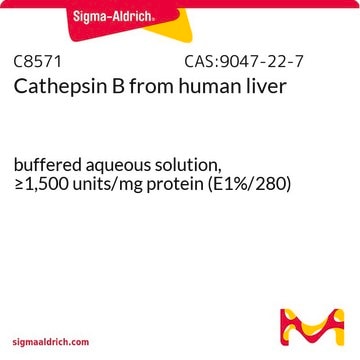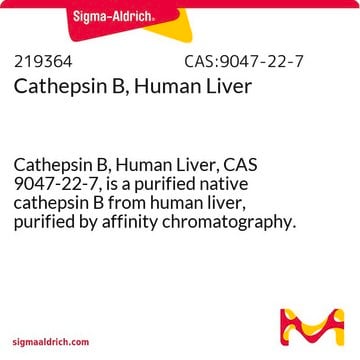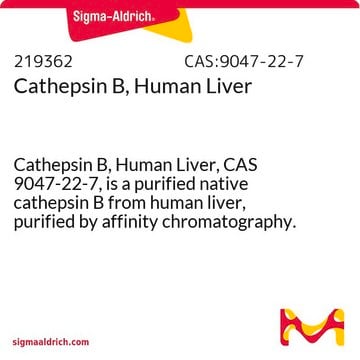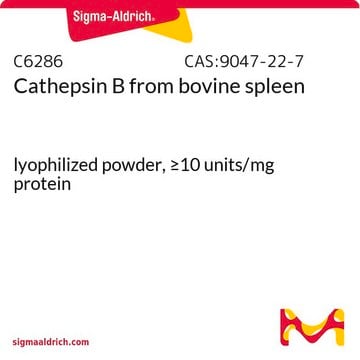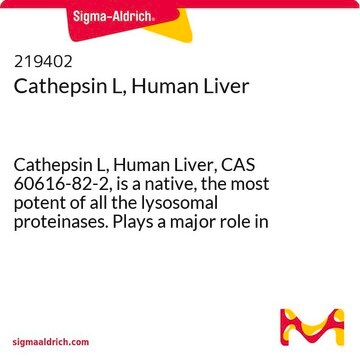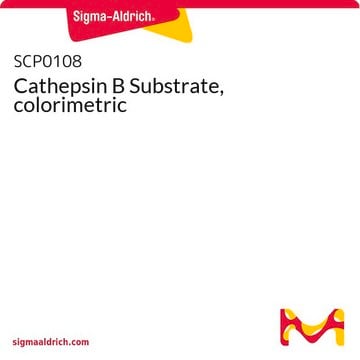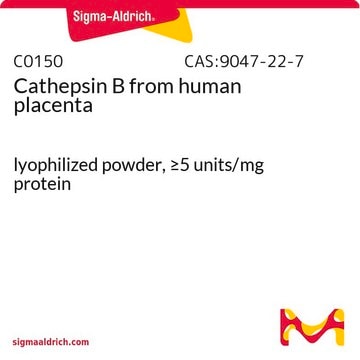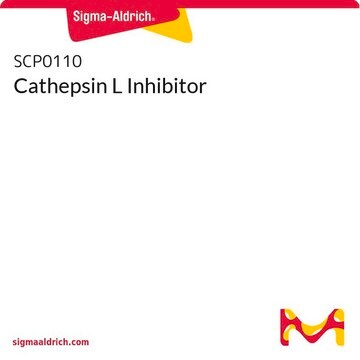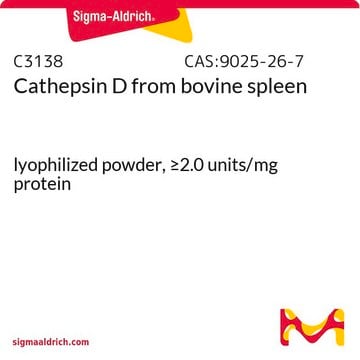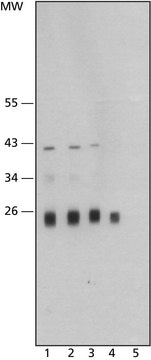C6854
Cathepsin L from human liver
≥0.5 units/mg protein, solution
Anmeldenzur Ansicht organisationsspezifischer und vertraglich vereinbarter Preise
Alle Fotos(1)
About This Item
CAS-Nummer:
MDL-Nummer:
UNSPSC-Code:
12352200
NACRES:
NA.32
Empfohlene Produkte
Biologische Quelle
human liver
Qualitätsniveau
Form
solution
Spezifische Aktivität
≥0.5 units/mg protein
Methode(n)
activity assay: suitable
pH-Bereich
4.5—5.5
UniProt-Hinterlegungsnummer
Anwendung(en)
pharmaceutical
Versandbedingung
dry ice
Lagertemp.
−20°C
Angaben zum Gen
human ... CTSL1(1514)
Allgemeine Beschreibung
The cathepsin L (CTSL) gene is mapped to human chromosome 9q21.33. It encodes a lysosomal cysteine proteinase that belongs to the peptidase C1 family. The enzyme is a dimer of a heavy (175 amino acids) and a light chain (42 amino acids) linked by disulfide bonds.
Anwendung
Cathepsin L (CTSL) from human liver has been used:
- to digest mutant transforming growth factor β-induced (TGFBIp) and LC3 (autophagosomes marker) proteins in vitro
- to digest the pH-dependent fibril of a pre-melanosomal protein (Pmel17) repeat domain (RPT) isoform and study the effect of pH on sRPT aggregation kinetics by tryptophan fluorescence
- to analyze the inhibition of CTSL by small molecules or drugs in a cell-free system
Biochem./physiol. Wirkung
Cathepsin L (CTSL) exhibits endopeptidase activity and breaks peptide bonds with aromatic residues. This enzyme is functional at pH 3.0–6.5 with thiol compounds. Elastin, collagen, and α-1 protease inhibitors act as substrates for cathepsin L (CTSL). CTSL cleaves several proteins including enzymes, receptors, and transcription factors. It is involved in antigenic peptide production and controls B-cells homeostasis. It is associated with myofibril necrosis and tumor progression. Increased expression of CTSL promotes metastasis and relates to poor prognosis in cancer patients. Increased expression of CTSL is observed in breast cancer. CTSL is implicated in glioblastoma multiforme (GBM), middle east respiratory syndrome (MERS), gingival overgrowth, and severe acute respiratory syndrome coronavirus 2 (SARS-CoV-2). It has a higher specific activity than cathepsin B and H in the degradation of a variety of physiological protein substrates.
Einheitendefinition
One unit will hydrolyze 1.0 μmole of Z-Phe-Arg-AFC per minute at pH 5.5 at 25 °C.
Physikalische Form
Solution in in 20 mM malonate, pH 5.5, 1 mM EDTA, and 400 mM NaCl.
Ähnliches Produkt
Lagerklassenschlüssel
10 - Combustible liquids
WGK
WGK 3
Flammpunkt (°F)
Not applicable
Flammpunkt (°C)
Not applicable
Analysenzertifikate (COA)
Suchen Sie nach Analysenzertifikate (COA), indem Sie die Lot-/Chargennummer des Produkts eingeben. Lot- und Chargennummern sind auf dem Produktetikett hinter den Wörtern ‘Lot’ oder ‘Batch’ (Lot oder Charge) zu finden.
Besitzen Sie dieses Produkt bereits?
In der Dokumentenbibliothek finden Sie die Dokumentation zu den Produkten, die Sie kürzlich erworben haben.
Kunden haben sich ebenfalls angesehen
Stefan Tholen et al.
Cellular and molecular life sciences : CMLS, 71(5), 899-916 (2013-07-03)
Endolysosomal cysteine cathepsins functionally cooperate. Cathepsin B (Ctsb) and L (Ctsl) double-knockout mice die 4 weeks after birth accompanied by (autophago-) lysosomal accumulations within neurons. Such accumulations are also observed in mouse embryonic fibroblasts (MEFs) deficient for Ctsb and Ctsl.
M Kathryn Liszewski et al.
Immunity, 39(6), 1143-1157 (2013-12-10)
Complement is viewed as a critical serum-operative component of innate immunity, with processing of its key component, C3, into activation fragments C3a and C3b confined to the extracellular space. We report here that C3 activation also occurred intracellularly. We found
Dexter N Dean et al.
Biochimica et biophysica acta. Proteins and proteomics, 1867(10), 961-969 (2019-02-05)
The pre-melanosomal protein (Pmel17) aggregates within melanosomes to form functional amyloid fibrils that facilitate melanin polymerization. The repeat domain (RPT) of Pmel17 fibrillates under strict acidic melanosomal pH. Alternative splicing results in a shortened repeat domain (sRPT), which also forms
Gustavo E Chavarria et al.
European journal of medicinal chemistry, 58, 568-572 (2012-11-22)
Kinetic analysis of the mode of inhibition of cathepsin L by KGP94, a lead compound from a privileged library of functionalized benzophenone thiosemicarbazone derivatives, demonstrated that it is a time-dependent, reversible, and competitive inhibitor of the enzyme. These results are
Bailey Miller et al.
Journal of natural products, 77(1), 92-99 (2013-12-25)
A number of marine natural products are potent inhibitors of proteases, an important drug target class in human diseases. Hence, marine cyanobacterial extracts were assessed for inhibitory activity to human cathepsin L. Herein, we have shown that gallinamide A potently
Unser Team von Wissenschaftlern verfügt über Erfahrung in allen Forschungsbereichen einschließlich Life Science, Materialwissenschaften, chemischer Synthese, Chromatographie, Analytik und vielen mehr..
Setzen Sie sich mit dem technischen Dienst in Verbindung.